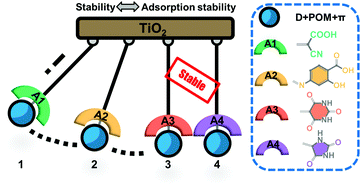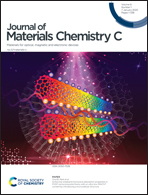A theoretical investigation on promising acceptor groups for POM-based dyes: from electronic structure to photovoltaic conversion efficiency†
Abstract
Theoretical calculations based on the density functional theory (DFT) and time-dependent DFT (TD-DFT) were employed to screen efficient acceptor group candidates for POM-based dyes. Compared to the commonly used cyanoacrylic acid acceptor group in dye 1, the acceptor groups, namely 2-hydroxy-4-(methyleneamino)benzoic acid, 5-methylenepyrimidine-2,4,6(1H,3H,5H)-trione and 5-methyleneimidazolidine-2,4-dione, in dyes 2–4 showed increased adsorption ability onto the TiO2 surface, which is beneficial for device stability. The reduced density gradient analysis offered a rich visualization of the weak interactions between the two monomers in the dimers of the dyes, indicating that the retarded aggregation in dyes 2–4 resulted from the hydrogen bonds present in the dimers of dyes 2–4, while π–π stacking interactions also existed in the dimer of dye 1. Particularly, dye 3 not only exhibited the broadest absorption spectrum, largest ICT parameters, largest short-circuit photocurrent density governed by electronic coupling and largest open-circuit photovoltage connected with the energy shift of the conduction band among dyes 1–4, but also possessed superior adsorption stability and the lowest interaction energy for the most stable dimer configuration, which can improve the photovoltaic efficiency of DSSCs. Thus, the 5-methylenepyrimidine-2,4,6(1H,3H,5H)-trione acceptor group in dye 3 can be a promising acceptor group candidate for high-performance dyes used in DSSCs.



 Please wait while we load your content...
Please wait while we load your content...